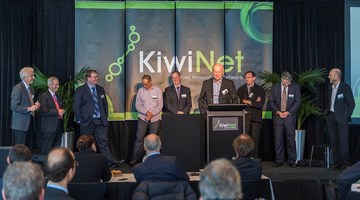TB Eradication and Research Manager for Tbfree New Zealand Paul Livingstone and Landcare Research scientist Bruce Warburton discuss their collaboration to address the problem of bovine tuberculosis (TB) in the dairy, beef and deer industries.
Bovine TB is one of the largest commercial biothreats for primary industries, with a risk of bovine TB being transmitted to livestock from wild possum populations in about 40% of the country. The partnership has been a major contributor of innovative strategies and technologies that has seen a significant reduction – more than 95% since 1994 – in the number of infected herds. In time, this will greatly reduce the $80 million per annum cost of keeping bovine TB at the very low levels needed to help maximize access to premium markets for our primary produce valued at around $20 billion per annum.
Transcript
Paul Livingstone
We’ve changed our TB control programme from one of trying to reduce infected herds to one of eradicating TB from possum populations.
Bruce Warburton
So to get rid of TB permanently, you have to clean up your herds, you also have to clean up the wildlife. You’ve got to be able to get possums down to a low level where their contact rate with each other is broken so they’re not giving the disease to each other, but then you’ve got to prove that you’ve got rid of it. So part of the paradigm shift in the science that is underpinning that is the development of a new tool that we can use now to come up with a probability that we’ve actually eradicated.
Paul Livingstone
The innovation is the software model that we use to identify whether in fact TB is still left in the possum population. The use of detection devices, and detection devices are very simple coreflute cards, which we can put out in the bush, and the possums, rats, mice, hedgehogs will bite them, and we can tell by the bite mark what the species was. So when we’re at low densities and we need to take animals for necropsy, we need to be able to find the most cost-effective way of identifying where they are in the habitat
Bruce Warburton
Well, if we can achieve eradication and then stop spending because we’ve declared TB eradication, it will save the country about half a billion dollars.
Paul Livingstone
It’s been very successful. We’ve reduced the number of infected cattle herds from nearly 1700 in 1994 down to 66 in 2012, so this is a, you know, a 94% reduction.
Bruce Warburton
I don’t think you could get a better collaboration. Tbfree is passionate about having research to underpin their policies and their practices, and that’s what gets us out of bed in the morning is to get our research into an organisation like Tbfree and seeing it make a difference basically overnight.
Acknowledgement
Video courtesy of Kiwi Innovation Network Limited
© Kiwi Innovation Network Limited, 2013


